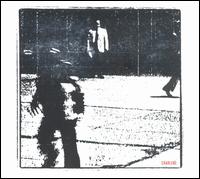|
|
 |
Dusted Reviews
Artist: Charlene Album: Charlene Label: Shark Attack Review date: May. 26, 2003 |

|
|
|
 |
Pop, Eating Itself
Juxtaposition is one of those things that keeps art (and its imitator life) interesting. Order and chaos, yin and yang, Run-DMC and Aerosmith — the possibilities are nearly limitless and the results are memorable more often than not. For Boston duo Charlene, the operative mixture is that of simple, pretty melodies and complex, mechanical backgrounds. The group's self-titled debut album finds the two elements, the song and the noise, in competition for your attention; each sometimes dominates and subsides, but neither ever appears totally free of the other. While their unrelenting coexistence can be frustrating at times, on the whole it makes for a record that's reasonably intriguing and, underneath all its extra layers, innocently pretty.
In all fairness, Charlene are playing at a juxtaposition that Wilco started cultivating a few years ago, from the self-consuming songs on Summerteeth to the bolder outlook of Yankee Hotel Foxtrot, on which the disintegration of a melody to complete disarray came to be just as important as the songs themselves. But the music on Charlene is wedded to its various interferences from the very beginning. Sure, some songs, like "Ripoff" and "Stunner," fade into oblivion by the end (the latter begins by emerging from it as well), but washes of static and feedback don't feel like ways out so much as natural parts of the music. Indeed, the appearance of a neat and distinct instrument is a rarity; with the exception of some guitar parts, each sound is distorted slightly, made just that little bit messier, and then reapplied to the whole. The drums are usually drowned in reverb, sometimes played live but more often by machine. The effect is a fuzzy mess through which moments of clarity occasionally shine, a sort of intentionally indistinct, multilayered collage. "While we apparently still record things without an adequate amount of 'high end,' all in all things have improved," reads an inscription inside the album. "We are quite pleased about this."
But what makes this inorganic exterior fascinating is the simplicity of what it covers. Each song introduces a discrete verse and chorus, never especially complicated, and repeats them languidly until either the static overtakes it or it can go no further without retreading its steps. There's not much in the way of bridges or tempo changes or climaxes — just simple melodic and lyrical themes, recurring persistently over slowly layering distractions. Beneath the rattle and hiss of a drum machine, "Sugarblocker" is a lovely pop song, while the quietly building strings on "Cathode" push it gradually toward a surprising majesty. Even the seven-and-a-half minute untitled track that follows, filled though it is with creaks and chirps like those ubiquitous Grandaddy instrumentals, is based at heart on one calmly repeated guitar phrase. It's interludes like these, the development and variation of the noise while the song itself travels in a circle, that make Charlene seem at once longer and stranger than it really is.
As it turns out, the cover of Charlene is a handy metaphor for the album itself: a photograph of a few people walking past, reproduced countless times until rendered nearly incomprehensible. There are humans writing these songs, as the odd plaintive verse or faintly rustic vocal will suggest, but the bare content of them is buried underneath the grainy interference of a mischievous amplifier or errant fax machine. The pictures on the back and inside have the same blurred and photocopied-beyond-identifiability quality, but the walking figures in them are surrounded with a thin halo of white, just as the basic and organic makeup of each song remains distinct under the surrounding imperfections. The photographs, however, are also make me wonder whether Charlene's two elements could exist without each other — the cover, cleaned up, would make a perfectly presentable image, but would there be anything to say about it? Individually, the parts wouldn't fare so well; the songs might get a bit stale at their present degree of repetition and extension, while the white noise and erratic cracks and beeps would make for a rather tedious (albeit very different) fifty minutes. In the end, Charlene's saving grace is not its human foundation or the mechanical layers on its surface, but an all-but-perfect balance between the two.
By Daniel Levin Becker
|







